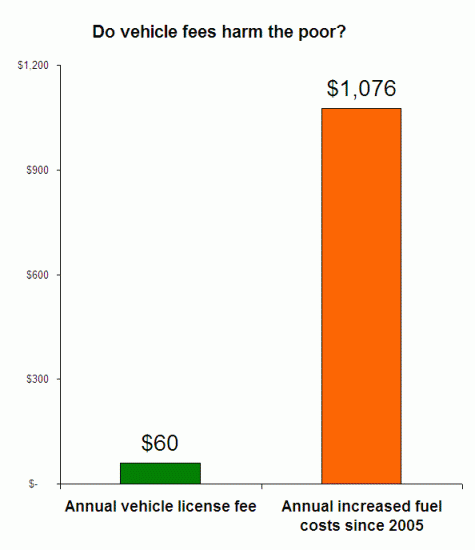Do vehicle license fees harm the poor?
Even if car fees actually are regressive—and I think the answer is far from clear—it’s wrong-headed to think that voting down a fee will somehow make driving affordable. Even a cursory look at history shows turning driving into a necessity is what really harms the poor.
In the early part of 2005, a driver in Seattle could fill up at less than $2 per gallon, but by 2011 that same driver was paying twice as much at the pump. Given typical driving habits, fuel prices alone added more than $1,000 to the annual cost of operating a car since 2005. In other words, world oil prices tacked on the equivalent of 18 of Seattle’s proposed vehicle license fees.
So let’s get this straight: driving in Seattle is not expensive because Mayor McGinn adjusted meter rates. It’s not expensive because the King County council floated a $20 car fee to preserve bus service. And it’s not expensive because a commercial parking tax raised the price of downtown garages by a buck or so. It’s expensive because oil companies get rich by selling expensive fuels that we’re addicted to.
That’s the bad news: driving is no longer an affordable option. It hasn’t been for years now, and there’s really not much we can do about it.
But there’s good news too: unlike rural areas, cities actually do have the power to make transportation affordable for those with low incomes. That’s because cities can provide real alternatives to driving and buying fuel. Cities can foster land use that puts housing in proximity to services and jobs, and cities can build low-cost transportation options that are safe and reliable.
There is a very uncomplicated reason why nearly 1 in 6 Seattle households goes without a car, including more than a quarter of all renters and 40 percent of the poor. Driving is just plain expensive.
It’s no accident that Seattle’s low income folks are already far more likely than others to get to work on a bus, on a bike, or on foot. It’s just basic economics. If we’re looking out for the interests of poorer households, the question is not whether we can somehow make driving affordable—plainly, we cannot—but whether we can provide alternatives.
Notes: I calculated fuel costs from the US Energy Information Administration’s retail price data for Seattle, comparing the average price of gasoline during February 2005 to the average price during September 2011. I assumed 11,000 miles of driving per year in a vehicle that gets 20 miles per gallon, which are typical figures. Obviously, driving less or driving a more efficient vehicle would reduce costs.
Also, my previous post on vehicle license fees garnered some good coverage (and comments) over at the news site PubliCola, here. It also earned me a few minutes on KUOW’s “The Conversation” with Ross Reynolds, starting at about 4:45, here.










Elaine Livengood
True, gasoline is very expensive. However, increasing license fees and costs for parking is not helping, either. A disproportionate amount of a low income persons income is spent on transportation. Not everyone can take the bus, as a large amount of poor people live in more rural areas. A trip to Seattle for a medical appointment is pricey. Buying a hybrid vehicle is completely off the budget charts! Living on less than $10,000.00 is a real challenge.
kurisu
Elaine – People who live in rural areas would not pay this fee! It only applies to Seattle residents, more of whom can reasonably expect to use new investments in reliable and fast bus service.
Jake Jackson
Seattle voters will crush this latest money grab by the bicycle lobby.
a seattlite
Good point, but would it not be a fairer comparison to take $60 * 6 (or 5) since the gas price increase is cumulative since 2005?
Eric de Place
No, seattlite, because that $1,076 figure is for just a single year of higher fuel costs — it’s an apples to apples comparison with a single year of $60 VLF fees.
Jake Jackson
I do trust you realize that the bicycle lobby’s concerted efforts to make driving even more expensive, and more of a hassle, will be met with a vigorous backlash by those of us who don’t think your crowd is superior, and who don’t appreciate your efforts to run our lives.
Eric Hess
Remind me again what part of international oil prices Seattle’s bicycle lobby controls?
Jake Jackson
Ah, yes, the attempt to make yourself look smarter than your opponent, when in fact you’ve only demonstrated your faulty comprehension.
Re-read my posting, in particular the 15th word, “even.” When you’ve done that, think really hard about why I put that word there, and what it means within the context of this discussion. If you need to know what “context” means, you can surely find a dictionary online.
In short: Yes, I know that oil prices have gone up. That’s an unavoidable issue, at least at the local level. The bicycle lobby, which despises cars and their drivers, wants to raise the costs even higher by adding charges that we can control.
This has been your elementary-school reading lesson for the day. You’re welcome.
Eric de Place
Jake,
I think you’ve misunderstood the point I was trying to make. The issue is not just that the VLF is a tiny percentage of recent fuel price increases, it’s that the most economically progressive thing we can do is give people options for reducing their dependence on fuel costs, which are punishingly high.
Trying to preserve driving as an affordable option is a fool’s errand that is quickly swamped by world oil prices.
I wrote more about this here: http://www.sightline.org/2011/09/28/are-vehicle-license-fees-regressive/.
Jake Jackson
Eric, no one’s fooled. Your crowd despises cars and drivers, and is pulling out all the stops to harass us. Expect a reaction.